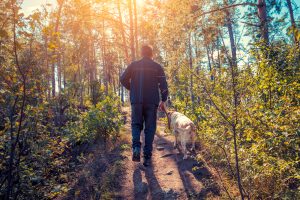When the COVID-19 pandemic spread to Canada and protective public health restrictions were implemented across the country, the need to understand how these measures would impact Canadian wellbeing and physical activity behavior emerged. For instance, the closure of recreation facilities, city parks and playgrounds would require Canadians to be innovative in their physical activity practices. How and whether those practices changed required a closer look. In response to this contemporary health concern and the emerging questions about its impacts, in April 2020 we launched a research project to better understand how Canadians are managing. The “Life in Lockdown” study will provide a snapshot of how the public health restrictions have impacted physical activity and wellbeing.
To this end, several variables were expected to influence how Canadians are adapting, including work-life changes, geographic locations, overall motivation and interest, and access to outdoor space. The following sections outline the key questions that we aim to answer through this cross-sectional study.
Key Question 1 – How are public health restrictions impacting physical activity levels?
The central question to this research is concerned with how restrictions will impact the physical activity of Canadians. For some, the closing of community centres, gyms and fitness facilities, combined with increased childcare responsibilities, will disrupt or completely stop their regular physical activity routine. However, with more flexible work-from-home schedules and saved commuting time, many Canadians may now find increased opportunity to be active. Physical activity has a number of proven physical and mental health benefits, but pre-pandemic, only 16% of Canadians met the recommended guidelines of 150 minutes of moderate to vigorous physical activity (Statistics Canada). Since scheduling barriers are an often-cited barrier to physical activity, this sudden disruption in schedule might prove to be a positive factor.
Key Question 2 – Which factors impact differences in physical activity levels among Canadians?
Whether physical activity levels increase or decrease during pandemic restrictions will be influenced by a wide variety of personal, social and/or environmental factors.

On an individual level, a plethora of personal factors will influence how Canadians cope with the restrictions and their impact on physical activity. For example, how individuals respond to the general stress and uncertainty that accompanies pandemic responses could facilitate or debilitate healthy behavioural responses. Individuals who utilize physical activity to cope with stress may increase this behavior, while those that show more depressive symptoms may lack motivation for physical activity engagement. Similarly, whether individuals perceive the restrictions as a threat to personal wellbeing or an opportunity to engage in innovative behaviours would significantly impact their ability to adapt.
Another factor that often impacts physical activity behavior is social support and peer involvement (Smith et al., 2017). Those living with family members or roommates may find that social support has increased as couples or families engaged in physical activity together due to restrictions on exercising with individuals outside of the household. Conversely, some have warned that physical distancing measures may strike a loneliness pandemic (Collie, 2020), so the ongoing lack of social support may negatively impact physical activity levels.
Environmental factors also impact physical activity levels. For our study, it is expected that proximity to accessible outdoor space will enable maintenance of increased of pre-pandemic physical activity levels. On the other hand, protective restrictions also mean that fitness centers are closed, sport programs are paused and park access is decreased, all further restricting opportunities for physical activity. Urban settings can make physical distancing difficult in indoor and outdoor spaces, and differences may emerge across Canada with divergent weather patterns that impact outdoor physical activity.
Key question 3 – How motivated are Canadians to engage in physical activity during the COVID-19 restrictions?
While self-efficacious beliefs and individual attitudes towards change and uncertainty would certainly impact how Canadians adapt, another critical predictor of physical activity engagement, and resulting positive health outcomes, is motivation (Texeira et al., 2012). Generally, individuals who experience higher degrees of internal motivation also experience greater positive emotions, such as joy, contentment and positive self-esteem, and increased levels of engagement. Importantly, self-determined motivation is impacted by autonomous choice and social relationships, two significant factors under pandemic siege.
Key question 4 – What impact might physical activity levels have on well-being?
It is also worth exploring how changes in physical activity would impact psychological and emotional well-being. With a noted increase in anxiety and depression that has been reported in the Canadian population (Forani, 2020) due to financial burden, childcare challenges, health anxiety or general disruption of daily life understanding the role that physical activity may play in alleviating some of this mental health burden is of interest. Physical activity is strongly associated with mental health and wellness – physically active individuals generally experience less stress, depression and anxiety (Chekroud et al., 2018), and physical activity has received attention in recent years as a potential treatment for depression and anxiety in addition to, or in place of, pharmaceuticals (Carek et al., 2011).
Key question 5 – How might outdoor physical activity impact well-being?

A final dimension worth exploring is how outdoor physical activity or exposure to nature will impact overall wellbeing. Research has indicated that exposure to nature increases positive psychological health outcomes such as happiness, mood and self-esteem, enhances vitality, and reduces stress (Nguyen & Brymer, 2018). A reduction in anxiety has been seen in individuals who feel a stronger connection to nature through physical exposure and comfort in a natural environment (Martyn & Brymer, 2016). Therefore, we are evaluating whether, and how often, physical activity was being done outdoors, and the degree of connectedness to nature that participants experience.
Implications
This study will provide a glimpse of how this sudden alteration in human behavior and psychology as imposed by massive disruptions to daily life is impacting Canadians. Findings will be valuable in the event of ongoing limitations or a secondary outbreak, providing insight for public health agencies, health professionals and policy makers to assist Canadians through these challenges. On an individual level, understanding related factors and nuances that impact physical activity adherence during this pandemic may provide valuable recommendations for Canadians seeking to better manage their lifestyles.
Findings from this research are now available! Read about the results of The Impact of COVID-19 on Physical Activity Behavior and Well-Being of Canadians in the UFV Today blog.